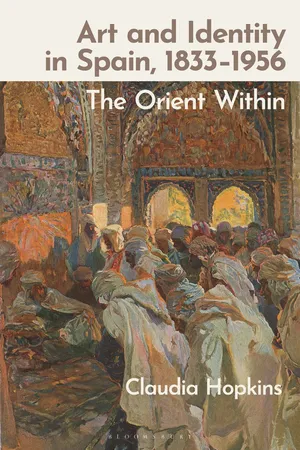
- 320 pages
- English
- ePUB (mobile friendly)
- Only available on web
About This Book
Richly illustrated, this is the first study in English to explore the longevity of Orientalist art in Spain over a period of 120 years. It highlights how artists in Spain shaped perceptions of Al-Andalus (Iberia under Islam 711–1492) and northern Morocco, from Spain's liberal revolution of the 1830s to the end of the Protectorate of Morocco in 1956. Combining art history with a cultural studies approach, and using exemplary case studies, Hopkins foregrounds the diverse issues that underpin Orientalist expression: reflections on history and the nation, cultural nationalism, gender and sexuality, aesthetics and art commerce, colonialism and racial thinking. In the process, the book challenges over-familiar understandings of Western Orientalism. Beyond Fortuny and Sorolla, many unfamiliar artists and exhibitions are introduced, amongst them Villaamil, whose nostalgic landscapes evoked the loss of Andalusi culture; Bécquer, who celebrated Spanish-Moroccan peace-making through the lens of Velázquez; the Symbolist Rusiñol, whose images of the Alhambra are infused with melancholy; Morcillo, whose extraordinary camp images opened a new space for male subjectivity; Tapiró and Bertuchi, who dedicated their lives to Morocco, and the Moroccan Sarghini, who participated in the state-funded Painters of Africa exhibitions in Franco's Madrid – an annual exhibition that served the colonial concept of a Hispano-Moroccan brotherhood under the dictatorship. This book traces the shifting impulses and meanings of Orientalist expression in Spain. It makes an original intervention in the field of Spanish art studies and contributes new material to the ongoing debates about Western Orientalism.
Frequently asked questions
Information
Table of contents
- Cover
- Halftitle Page
- Title Page
- Contents
- List of Plates
- List of Figures
- Acknowledgements
- Introduction: The Orient Within
- 1 Transcultural Nostalgia
- 2 Collapsing Time: Old and New Conquests
- 3 The Poetics of Victory after 1860: Northern and Southern Perspectives
- 4 From Ethnographic to Camp Masculinity
- 5 A New Image: The Alhambra around 1900
- 6 Settling in Morocco
- 7 Art as Protectorate Propaganda: ‘A Human and Placid Maghreb’
- 8 ‘Morocco is Not Exotic’: Exhibitions under Franco
- Epilogue: Switching Perspectives
- Notes
- Select Bibliography
- Index
- Imprint